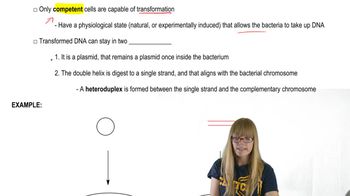Describe the role of ¹⁵N in the Meselson–Stahl experiment.
Table of contents
- 1. Introduction to Genetics51m
- 2. Mendel's Laws of Inheritance3h 37m
- 3. Extensions to Mendelian Inheritance2h 41m
- 4. Genetic Mapping and Linkage2h 28m
- 5. Genetics of Bacteria and Viruses1h 21m
- 6. Chromosomal Variation1h 48m
- 7. DNA and Chromosome Structure56m
- 8. DNA Replication1h 10m
- 9. Mitosis and Meiosis1h 34m
- 10. Transcription1h 0m
- 11. Translation58m
- 12. Gene Regulation in Prokaryotes1h 19m
- 13. Gene Regulation in Eukaryotes44m
- 14. Genetic Control of Development44m
- 15. Genomes and Genomics1h 50m
- 16. Transposable Elements47m
- 17. Mutation, Repair, and Recombination1h 6m
- 18. Molecular Genetic Tools19m
- 19. Cancer Genetics29m
- 20. Quantitative Genetics1h 26m
- 21. Population Genetics50m
- 22. Evolutionary Genetics29m
8. DNA Replication
Overview of DNA Replication
Problem 8
Textbook Question
How did Kornberg assess the fidelity of DNA polymerase I in copying a DNA template?
 Verified step by step guidance
Verified step by step guidance1
Understand the concept of fidelity in DNA replication: Fidelity refers to the accuracy with which DNA polymerase copies the DNA template, ensuring minimal errors during replication.
Recognize the role of DNA polymerase I: Kornberg studied DNA polymerase I, an enzyme responsible for synthesizing DNA by adding nucleotides complementary to the template strand.
Learn about the experimental setup: Kornberg used a DNA template and provided the necessary components for DNA synthesis, including nucleotides and DNA polymerase I, in a controlled environment.
Examine the method to assess fidelity: Kornberg measured the incorporation of correct nucleotides versus incorrect ones during DNA synthesis. This involved analyzing the newly synthesized DNA for errors using biochemical techniques such as base composition analysis or enzymatic digestion.
Understand the significance of the results: Kornberg demonstrated that DNA polymerase I had high fidelity, meaning it accurately copied the DNA template with minimal errors, which was crucial for understanding the enzyme's role in DNA replication.
 Verified video answer for a similar problem:
Verified video answer for a similar problem:This video solution was recommended by our tutors as helpful for the problem above
Video duration:
1mPlay a video:
Was this helpful?
Key Concepts
Here are the essential concepts you must grasp in order to answer the question correctly.
DNA Polymerase I Function
DNA Polymerase I is an enzyme responsible for synthesizing new DNA strands by adding nucleotides complementary to a DNA template. It plays a crucial role in DNA replication and repair, ensuring that genetic information is accurately copied. Understanding its mechanism is essential for assessing its fidelity in copying DNA.
Recommended video:
Guided course

Functional Genomics
Fidelity in DNA Replication
Fidelity refers to the accuracy with which DNA polymerases replicate DNA. High fidelity is critical to prevent mutations, which can lead to genetic disorders or cancer. Factors influencing fidelity include the enzyme's proofreading ability, which allows it to correct errors during DNA synthesis.
Recommended video:
Guided course

Steps to DNA Replication
Experimental Assessment Techniques
Kornberg employed various experimental techniques to assess the fidelity of DNA Polymerase I, such as using labeled nucleotides to track incorporation and measuring the frequency of errors. These methods allowed for quantifying how often the enzyme made mistakes while copying a DNA template, providing insights into its accuracy.
Recommended video:
Guided course

Transformation
Related Videos
Related Practice
Textbook Question
815
views


